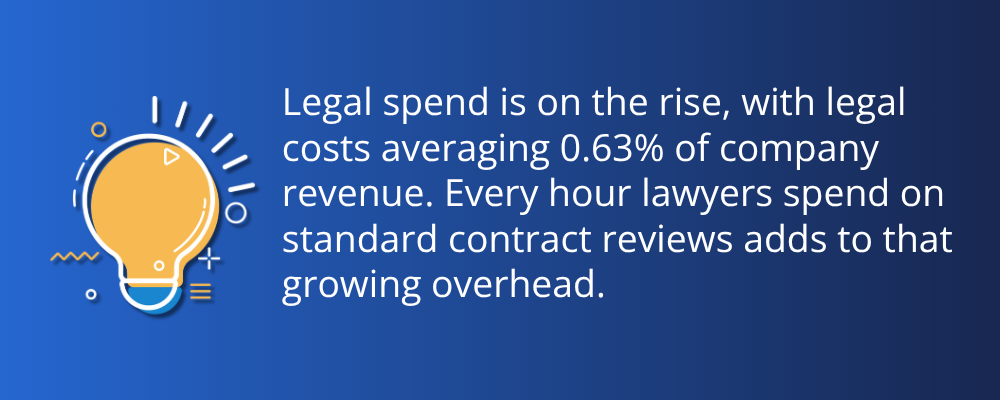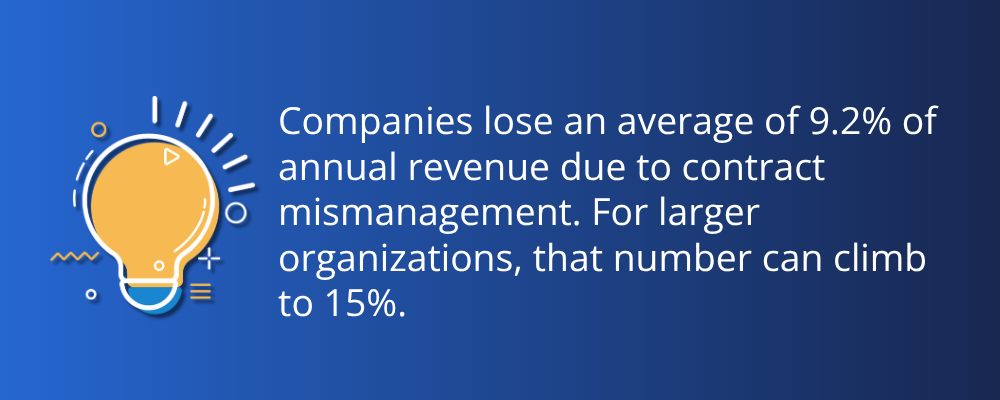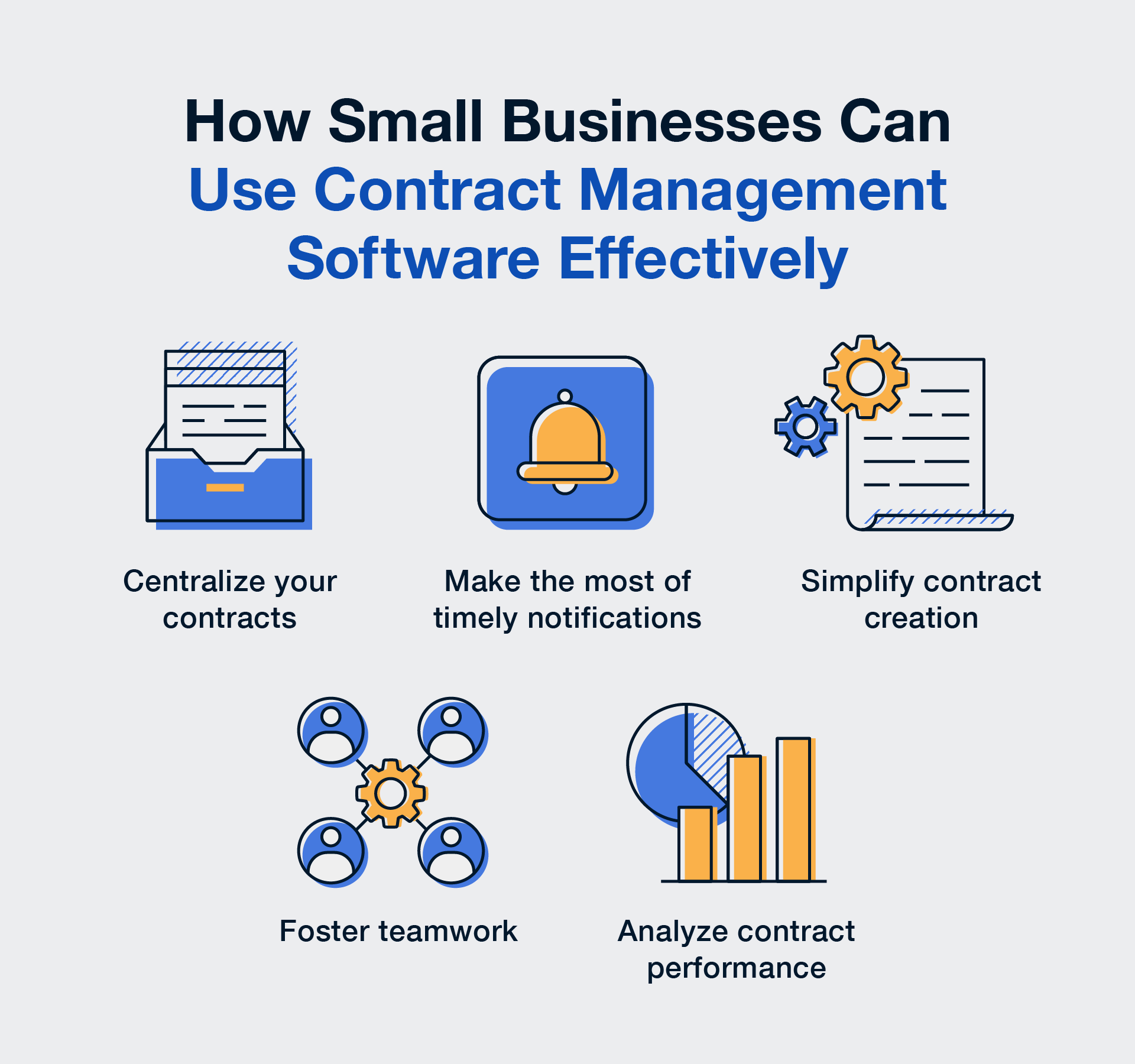Most contracts never change. So why are you still paying lawyers to review them?
Most companies still send every contract through legal. From NDAs to vendor agreements, everything ends up in a lawyer’s inbox. The problem? Lawyers are expensive—often $300 to $500 an hour—and most of those contracts don’t actually need their expertise. That’s hours of high-cost legal time spent rubber-stamping agreements that rarely change.
And the numbers back it up. The Association of Corporate Counsel reports that contract work is one of the biggest drains on in-house legal teams. In other words, highly trained lawyers are spending big chunks of their time evaluating routine contracts instead of focusing on the tricky stuff.
That’s where contract lifecycle management (CLM) comes in. CLM is simply the process of managing contracts from draft to renewal. When it’s done manually, it slows deals, adds cost, and ties legal up in admin tasks. With modern CLM software, the repetitive work moves quickly, and legal can finally focus on strategy—not admin.
TL;DR
Manual contract checks are expensive, slow, and risky. Lawyers spend costly hours reviewing contracts that don’t change. Research shows companies lose nearly 9.2% of annual revenue to contract mismanagement. Contract lifecycle management (CLM) software and AI streamline standard contract work, cut legal overhead, improve governance, and accelerate revenue recognition. With ContractSafe, businesses get all the benefits of CLM—without a massive legal team or massive budget.
TABLE OF CONTENTS:
- What’s the Real Cost of Sending Every Contract to Legal?
- Contracts Are Operational, Not Just Legal
- Why Manual Contract Review Isn’t Just Inefficient—It’s Risky
- How CLM Software Streamlines Routine Contract Reviews
- AI in CLM: Automating the 90% That Never Change
- When Should Legal Review Contracts—And When Is It Unnecessary?
- What’s the ROI of Contract Lifecycle Management
- How CLM Will Change Legal’s Role
- How Does ContractSafe Make CLM Simple?
- FAQs: How CLM Transforms Legal’s Role
What’s the Real Cost of Sending Every Contract to Legal?
Lawyers are highly skilled—and highly expensive. But many companies still send every boilerplate NDA, vendor agreement, and customer contract through legal sign-off.
Notably, The Association of Corporate Counsel reports that median legal spend rose from $2.4M to $3.1M in 2023, with legal costs averaging 0.63% of company revenue. Every hour lawyers spend on standard contract passes adds to that growing overhead.

Here’s the problem: even simple contracts can spend days—or weeks—stuck in a legal queue before anyone signs them.
That delay has real costs—and it shows why companies need better contract lifecycle management practices to keep deals moving.
- Slower revenue recognition. Deals can’t close until contracts are signed.
- Wasted legal spend. Standard contract oversight eats up budget better spent elsewhere.
- Lost opportunities. Competitors move faster while you wait on approvals.
These delays don’t just slow deals—they ripple through the entire business, tying up working capital, dragging out sales cycles, and leaving finance in the dark on cash flow.
Contracts Are Operational, Not Just Legal
Contracts don’t just protect you in court—they drive daily business operations:
- Finance tracks payment terms and invoices.
- Sales depends on renewal dates and pricing terms.
- Operations monitors obligations and service levels.
Treating contracts as strictly “legal” misses the point. They’re business-critical documents that need visibility across teams. Strong contract lifecycle management ensures contracts flow smoothly across finance, sales, and operations instead of becoming a bottleneck.
👉 Research confirms it: World Commerce & Contracting reports that roughly 26% of an organization’s workforce is involved in contract management in some way—proof that contracts aren’t just a legal function, but a company-wide responsibility.
Why Manual Contract Review Isn’t Just Inefficient—It’s Risky
Manual legal processes don’t always reduce risk—in many cases, they introduce new ones:
- Missed renewal dates lead to surprise expenses.
- Compliance slips through the cracks without consistent tracking.
- Human error creeps in during repetitive legal passes.
- Leadership loses visibility when contracts are buried in inboxes or spreadsheets.
And the financial impact is hard to ignore. According to World Commerce & Contracting, companies lose an average of 9.2% of annual revenue due to contract mismanagement. For larger organizations, that number can climb to 15%. Slow negotiations, poor visibility, and manual processes aren’t just frustrating—they directly erode the bottom line.

In short: the very process meant to protect you can end up costing you more—and it makes effective contract lifecycle management nearly impossible.
The bigger risk? You lose speed and predictability. Deals stall, revenue recognition gets pushed out, and critical obligations slip through unnoticed. While you’re stuck chasing signatures and deadlines, competitors with smarter processes move twice as fast.
That’s why companies are moving away from manual oversight and using CLM software to automate the routine while flagging exceptions for legal.
RELATED: 5 Proven Tips for Better Contract Tracking
How CLM Software Streamlines Routine Contract Reviews
Contract lifecycle management (CLM) software changes the equation. Instead of pushing every contract to legal, CLM automates and organizes the process from creation to renewal.
- Automation: Typical contracts handled automatically, without legal bottlenecks
- Smart alerts: Never miss a deadline or renewal again.
- Searchability: Instantly find any contract—even scanned PDFs.
- Audit trails: Every action logged for regulatory tracking.
- Exception handling: Only unusual clauses get flagged for human inspection.
With CLM, the full lifecycle—drafting, negotiation, execution, compliance, and renewal—becomes visible and manageable across the business. That shift frees people from chasing paperwork and lets them focus on strategy, customers, and growth.
AI in CLM: Automating the 90% That Never Change
Artificial intelligence makes CLM even more powerful by handling repetitive “pattern-matching” tasks:
- Extracting key terms like payment dates or liability caps
- Comparing contracts against playbooks or templates
- Flagging risks and non-standard clauses
- Summarizing agreements for business users
This doesn’t replace lawyers—it protects their time. They still own the 10% of contracts that truly require judgment and strategy (like M&A, partnerships, or IP). The other 90%? AI and CLM handle them faster—and with fewer errors.
RELATED: Contract Lifecycle Management in 2025: How AI is Changing the Game
When Should Legal Review Contracts—And When Is It Unnecessary?
Legal still plays a critical role. But their focus should be on:
- Mergers and acquisitions
- Complex, high-value partnerships
- Intellectual property disputes
- Regulatory issues and litigation
With CLM, everyday contracts move quickly through automated processes while legal stays focused on strategy. It’s not about cutting lawyers out—it’s about making sure their time protects the business where it matters most.
What’s the ROI of Contract Lifecycle Management Software
Companies that adopt CLM software see measurable returns across the business—not just lower legal costs, but faster revenue, stronger governance, and healthier cash flow.
- Faster deals: Contract cycle times shrink from weeks to days, which means revenue is recognized sooner.
- Lower costs: Common contract sign-offs shift to automation, cutting back on hours of expensive attorney time.
- Better governance: Automated audit trails reduce the risk of missed obligations or failed audits.
- Healthier cash flow: Smart alerts keep renewals and payment terms on track, avoiding costly surprises.

👉 The takeaway is clear: contract lifecycle management software doesn’t just cut attorney fees. It accelerates revenue, strengthens regulatory adherence, and frees your team to focus on growth. In today’s competitive market, delaying CLM adoption isn’t just inefficient—it’s costly.
How CLM Software Will Change Legal’s Role
Within a few years, asking lawyers to review every NDA will feel as outdated as faxing signed agreements. CLM shifts legal away from routine contract checks and toward the high-value work that actually protects the business.
Here’s what that future looks like:
- AI handles the repetitive 90%. Routine contracts are extracted, flagged, and routed automatically.
- Legal focuses on strategy. Instead of stamping boilerplate NDAs, lawyers spend their time on mergers, partnerships, and complex negotiations.
- Business teams gain visibility. Finance, sales, HR, and operations can track obligations and deadlines in real time without waiting on legal.
- Leaders see measurable impact. Faster cycle times mean earlier revenue recognition, stronger governance, and more capital freed up for growth.
The legal department doesn’t disappear in this future—it becomes more strategic, less administrative. Companies already moving to CLM are seeing that shift today. The rest risk being left behind, not because their lawyers aren’t skilled, but because manual processes keep the whole business stuck in the past.
RELATED: 14 Best Contract Management Software: 2025 Buyer’s Guide
How Does ContractSafe Make CLM Simple?
Most companies don’t need a heavyweight, consultant-driven CLM system. They need something practical: a way to stop wasting money on legal passes for boilerplate contracts, keep obligations from slipping, and give every team visibility into the agreements that drive the business.
That’s exactly what ContractSafe delivers. Our platform makes contract lifecycle management refreshingly simple by combining:
- AI for routine extraction – extracts key terms, with every contract still getting human review. Lawyers focus only on the ones that need real expertise.
- Smart alerts – no more missed renewals or hidden auto-renewal clauses draining revenue.
- Audit trails – every action logged automatically to keep you audit-ready.
- Searchable repository – find any contract instantly, even scanned PDFs.
- Cross-team visibility – finance, sales, HR, and operations get the insights they need without waiting on legal.
👉 That means faster deals, lower costs, and fewer headaches — all without hiring more lawyers or buying complex, consultant-heavy systems.
With ContractSafe, you don’t need a massive legal department—or a massive budget—to get CLM right. You just need a platform built to take the bottleneck out of contracts so your business can move faster, stay compliant, and keep growing.
FAQs: How CLM Transforms Legal’s Role
What is Contract Lifecycle Management (CLM)?
Contract lifecycle management (CLM) is the process of managing contracts from drafting through negotiation, approval, signature, performance, renewal, and expiration. The goal is to save time, reduce risk, and maximize contract value.
CLM turns contracts from static documents into active business assets. With the right process and tools, teams can improve visibility, streamline workflows, and make sure obligations are met at every stage of the contract.
How does CLM change the role of legal teams?
Instead of rubber-stamping NDAs or vendor agreements, legal teams focus on high-value work like mergers, partnerships, and regulatory issues. CLM software handles the boilerplate contracts and flags the exceptions that actually need legal judgment.
Does CLM replace lawyers?
No. CLM doesn’t replace lawyers—it protects their time. AI and automation take care of repetitive data extraction and contract tracking, while lawyers step in only on contracts that truly require expertise.
Which contracts still need legal review?
Legal should focus on complex or high-risk contracts, like M&A, intellectual property, or regulatory-heavy agreements. Standard or boilerplate NDAs, vendor agreements, and customer terms can move quickly through automated CLM workflows.
What are the business benefits of shifting legal’s role with CLM?
Companies see faster contract cycles, lower legal spend, stronger compliance, and better cash flow. Freeing legal from routine reviews means deals close faster and the whole business moves more efficiently.
Can small businesses use CLM to reduce reliance on legal?
Yes. CLM tools like ContractSafe make it easy for small businesses to manage contracts without a large in-house legal team, while still ensuring obligations are tracked and risks are flagged.


















